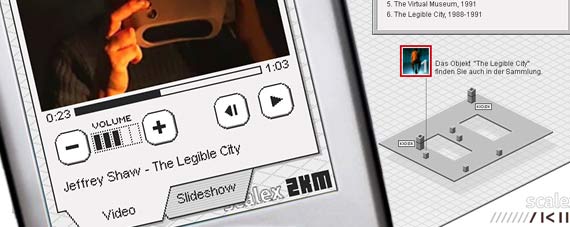The Knowledge Editor is a tool that aids the designer(s) of an exhibition in creating and managing an exhibition’s underlying 'knowledge' data in terms of thematic descriptions and associating exhibition items with several digital representations. In a more technical sense the editor is used for creating the ontology that describes a particular exhibition and that gets interpreted by the Storyliner. The Knowledge Editor supports the workflow of the exhibition creators and makes it possible to design a Scalex driven exhibition without having know how about knowledge representation and the underlying technology. But the Knowledge Editor is neither another tool for content creation or content manipulation nor another project management tool. The Scalex system and the Knowledge Editor in particular, rely on ready made digital content which is produced using existing content authoring tools (e.g. HTML editors, Macromedia Flash or Director, SMIL editors, …). The Knowledge Editor consists of the modules Resource Manager, Exhibition Designer, Profile Editor and a Notes Tool.
The SCALEX Storyliner transforms the multidimensional knowledge map into a set of storylines adapted to different user models. The storyliner organises the results of user input or tracked user behaviour for the subsequent phases of a visit, and is thus a prerequisite for the synchronisation of the entire digital exhibition. The output of the storyliner is a collection of editable linear traversals of the exhibition material, which correspond to the different rooms of an exhibition. The storyliner will have a similar functionality as a level editor for computer games, and enables the planning of interactive behaviour for different virtual exhibition objects. This document can be edited without consequences for the underlying knowledge database, and can also be modified by changes in the metadata. The algorithm for this transformation is a crucial delivery of the entire project. The output of the storyliner is a collection of editable linear traversals of the exhibition material, which correspond to the different rooms of an exhibition. The storyliner will have a similar functionality as a level editor for computer games, and enables the planning of interactive behaviour for different virtual exhibition objects. The output of the storyliner is formally a set of XML-documents and functionally a set of storyboards describing different possible exhibition stories. This document can be edited without consequences for the underlying knowledge database, and can also be modified by changes in the metadata. The algorithm for this transformation is a crucial delivery of the entire project.
The SCALEX Profiler is a tool, which more or less is invisible to the exhibition visitor. For the first Model Exhibition the profile consisted of a language selector and four continuous parameters. Sliders are used for setting those profile values. In addition to that, the visitor is able to decide which of the four parameters are more or less important to him. In the profile selection dialog used during the second model exhibition, icons symbolize the different profiles and the user chooses his profile by selecting one of it. For the presentation of the final adaptive exhibition, Profiler and Storyliner work closely together.
The Exhibition Player adapts the presentation of a digital exhibition to the particular needs and knowledge of individual visitors and to the exhibition space. It relies on a converter for the transformation of all required files and documents into the format compatible *with user devices. The architecture will be scalable, starting with the presentation on one or two monitors/video projectors and allowing the addition of further display devices and media types. The SCALEX architecture can be applied to portable and static devices, such as PDAs and Webpads used as controllers of large screen displays.
SCALEX will be developed in 'real-world' scenarios:
1. the presentation of digital media and information as a supplement to an 'analogue' presentation of bjects in a static museum exhibition
2. a purely virtual exhibition
3. a school version of a virtual exhibition
Model exhibitions for these three different
use cases were developed with museums.
The converter uses XSLT for the conversion
of XML documents and is able to convert and/or compress binary data with standard
technologies. The converter generates a linking structure and the interactive
capabilities of the target data. It can also be used for the direct publication
of the exhibition via the web.
The player will rely on standard Internet and open source technology, based on an application server and a streaming media server customised to the needs of exhibitions. The player contains a synchroniser that synchronises the reaction of exhibits to user interventions, and a profiler that tracks user behaviour for displaying personalised content and giving a feedback to the knowledge editor and storyliner.
Different media are integrated as MIME-types depending on the display properties and the processing power of clients and server.
These exhibitions will be developed in collaboration with institutions renowned for the employment of digital media in the context of exhibitions. SCALEX will be marketed as a combination of server modules and consulting/exhibition preparation services by the industrial partners of the consortium.


